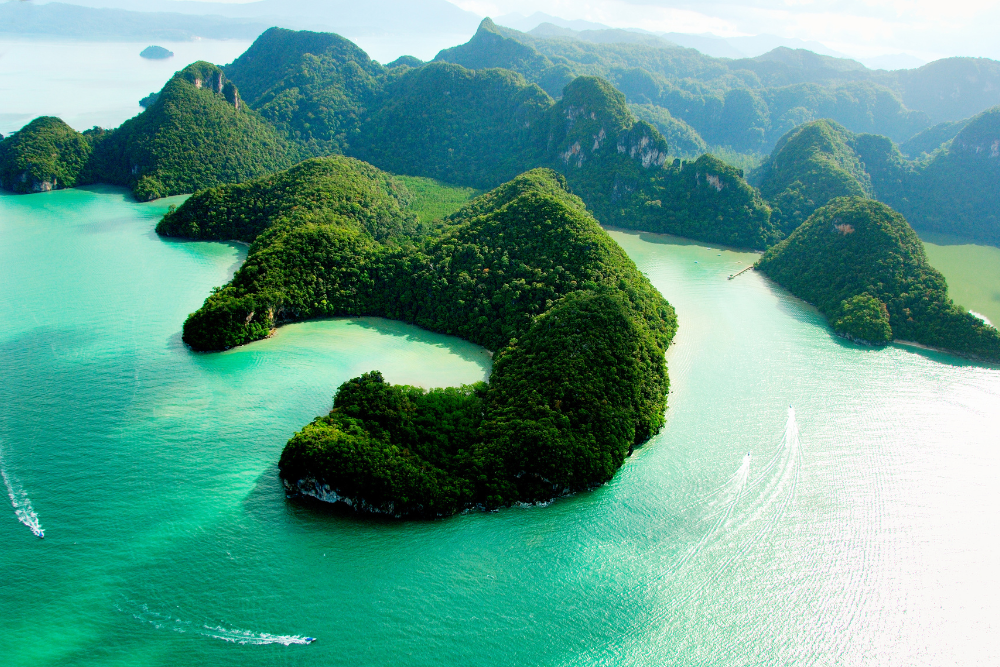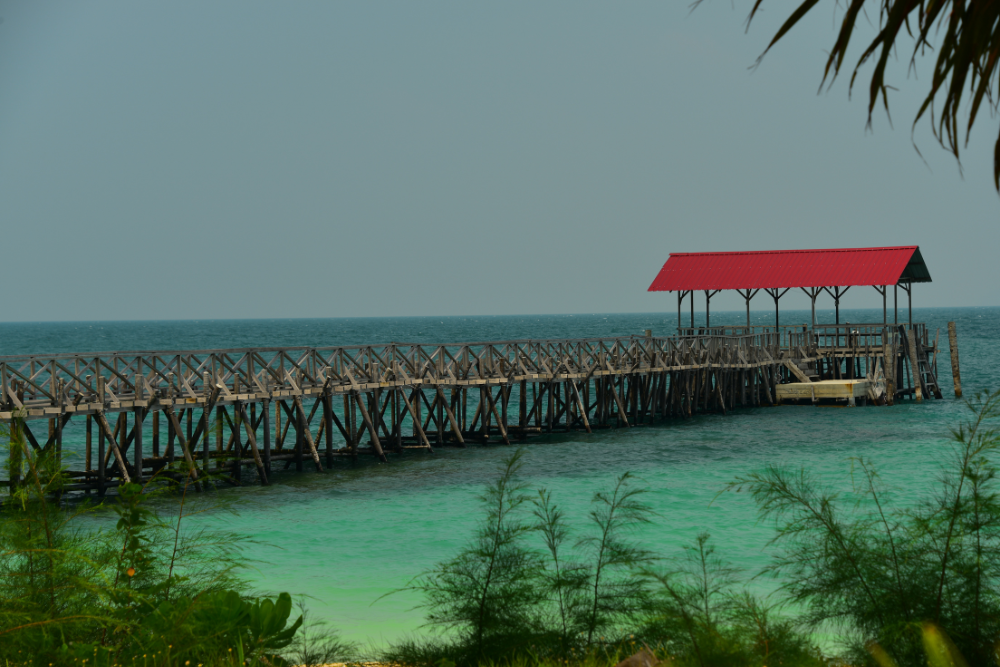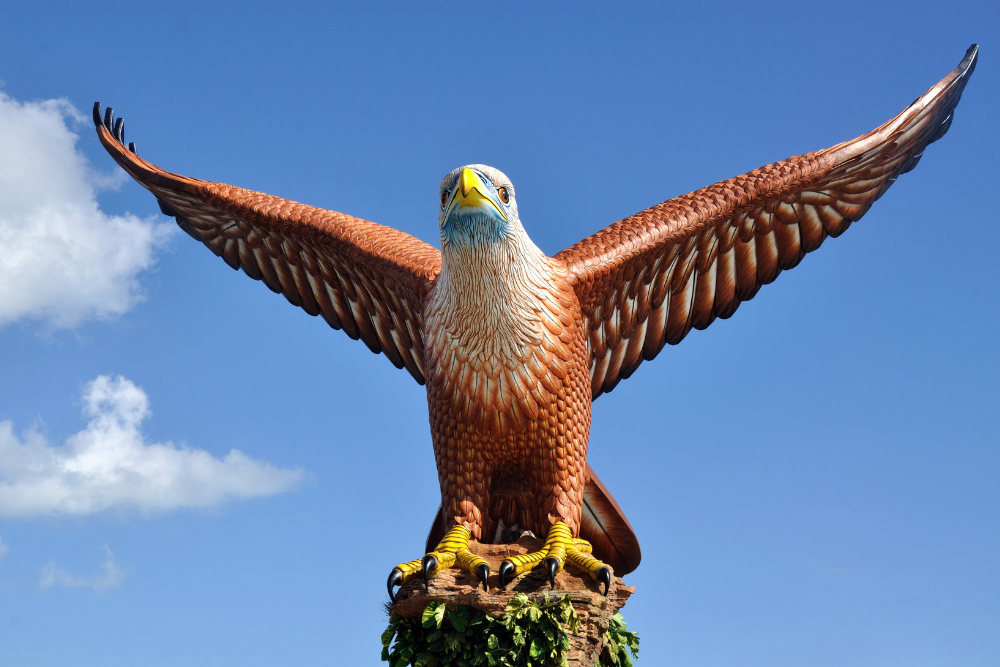Langkawi, a stunning archipelago off the northwest coast of Malaysia, is a tropical paradise renowned for its white-sand beaches, crystal-clear waters, and lush rainforests. It’s not just the main island that draws tourists; Langkawi’s 99 islands (and even more islets) make it an ideal destination for island-hopping. Whether you’re looking for secluded beaches, vibrant marine life, or historical landmarks, Langkawi offers a variety of experiences across its islands. In this guide, we’ll take you through the best islands to visit in Langkawi and the essential things to know for a memorable island-hopping adventure.
1. Pulau Dayang Bunting: The Lake of the Pregnant Maiden
Pulau Dayang Bunting (translated as the “Island of the Pregnant Maiden”) is one of Langkawi’s most famous islands. Its name is derived from the shape of the island, which, when viewed from a distance, resembles a pregnant woman lying on her back. The island is home to one of Langkawi’s natural wonders, Dayang Bunting Lake, a freshwater lake nestled in the center of the island. The lake is surrounded by steep hills and lush greenery, making it a serene and picturesque location.
Visitors to Pulau Dayang Bunting can take a boat from Langkawi and explore the island. Once there, you can swim in the tranquil waters of the lake, which is known for its healing properties. It’s also a great spot for a picnic or a nature walk. Hiking trails leading up to panoramic viewpoints give you a spectacular view of the island and its surrounding areas, making it an excellent choice for nature lovers.
Tip: The island is part of the Langkawi Geopark, so don’t miss the opportunity to enjoy a boat ride around the island to explore the unique limestone formations that dot the landscape.
2. Pulau Payar Marine Park: A Snorkeler’s and Diver’s Paradise
If you’re looking to explore Langkawi’s underwater world, a trip to Pulau Payar Marine Park is a must. Situated about 30 kilometers south of Langkawi’s main island, this marine park is a haven for snorkeling and diving enthusiasts. The crystal-clear waters are home to vibrant coral reefs, colorful marine life, and an abundance of fish species. Common sights include angelfish, parrotfish, clownfish, and even reef sharks.
Pulau Payar consists of several smaller islands, including Pulau Payar, Pulau Kaca, and Pulau Segantang. Most visitors arrive on a boat tour from Langkawi, where you can spend the day snorkeling, diving, or simply relaxing on the beach. The shallow waters around the island are perfect for novice snorkelers, while experienced divers can venture deeper to explore the coral gardens.
There are also opportunities for glass-bottom boat rides for those who prefer to stay dry but still want to experience the marine life beneath the surface. The Marine Park is a protected area, so it’s essential to follow all guidelines to preserve the delicate ecosystem.
Tip: Tours to Pulau Payar typically include equipment rental, refreshments, and lunch. It’s best to book in advance, especially during peak tourist seasons.
3. Pulau Tuba: A Quiet Retreat
While Langkawi’s main island offers a bustling atmosphere, Pulau Tuba provides a peaceful retreat, offering visitors a glimpse of traditional Malaysian island life. Located just south of Langkawi’s main island, Pulau Tuba is known for its lush landscapes, quiet beaches, and a slower pace of life. This island is perfect for those looking to escape the crowds and experience the quieter side of Langkawi.
Pulau Tuba is also known for its fishing villages, where you can observe the local way of life and even take a boat ride to see the local fishermen at work. It’s an excellent spot for kayaking, cycling, or simply relaxing in nature. The island is relatively untouched by mass tourism, making it a great spot for those who want to explore the more authentic, rustic side of Langkawi.
Tip: Pulau Tuba is less touristy, so don’t expect many modern amenities. Bring some snacks and water with you if you plan to stay for the day.
4. Pulau Singa Besar: Wildlife and Nature Lovers’ Haven
For nature and wildlife enthusiasts, Pulau Singa Besar is an exciting island to explore. Known as the “Big Lion Island,” it is home to a diverse range of flora and fauna, including various species of birds, monkeys, and reptiles. The island is part of the Langkawi Wildlife Sanctuary, which aims to protect the region’s unique wildlife.
Visitors can take a boat tour from Langkawi to Pulau Singa Besar, where they can enjoy a guided nature walk, birdwatching, or even go on a wildlife safari. The island is also home to several pristine beaches, perfect for a swim or picnic. Along the way, you may spot macaques and monitor lizards in the wild, making it a great place to enjoy Langkawi’s natural beauty.
Tip: Bring along your binoculars if you’re interested in birdwatching, as the island is home to a variety of species, including hornbills and eagles.
5. Pulau Beras Basah: Sandy Beaches and Crystal-Clear Waters
Pulau Beras Basah, or “Wet Rice Island,” is a popular stop for tourists looking to enjoy Langkawi’s pristine beaches. The island is only a short boat ride from the main island of Langkawi, and it offers some of the most beautiful beaches in the region. The soft, powdery sand and crystal-clear waters make it an ideal spot for swimming, sunbathing, and relaxing.
There’s also a small beachside café where you can enjoy local snacks and cool drinks. The calm waters around the island are perfect for water sports such as kayaking, and the surrounding coral reefs offer opportunities for snorkeling. Pulau Beras Basah is a great spot for a family outing, a romantic getaway, or just a peaceful day on the beach.
Tip: If you prefer a quieter, less crowded experience, try to visit early in the morning or later in the afternoon when the island is less busy.
6. Pulau Langkawi: The Main Island
While the main island of Langkawi is often the starting point for many island-hopping tours, it’s still worth exploring the many attractions and natural wonders it offers. Langkawi itself is home to stunning beaches, lush jungles, and iconic landmarks such as the Langkawi Sky Bridge, Langkawi Cable Car, and Langkawi Wildlife Park.
The island also offers various other outdoor activities such as jungle trekking, mangrove tours, and sunset cruises. For those who enjoy history and culture, a visit to the Langkawi Craft Complex or the Langkawi Art Museum can add an educational touch to your trip.
Tip: Don’t miss a visit to the Langkawi Cable Car and Sky Bridge, which offer spectacular views of the island and the surrounding archipelago. You’ll also find nature trails and wildlife observation spots on the main island.
Practical Tips for Island-Hopping in Langkawi
- Book in Advance: Especially during peak tourist seasons, it’s best to book your island-hopping tours ahead of time to secure your spot and ensure availability.
- Pack Essentials: Bring along sunscreen, a hat, swimwear, comfortable shoes for walking or hiking, and a camera to capture the stunning views.
- Respect Nature: Langkawi’s islands are part of protected natural reserves, so be mindful of the environment. Avoid littering, refrain from touching coral reefs, and always follow the guidelines set by tour operators.
- Water Sports: Many islands offer activities like kayaking, jet-skiing, and snorkeling, so if you’re interested in water sports, check with your tour operator for the available options.
- Timing Your Visit: The best time to visit Langkawi for island-hopping is during the dry season, which typically runs from November to April. The weather is warm, and the seas are calm, making it ideal for boat tours.
Conclusion
Island-hopping in Langkawi is an unforgettable adventure, offering a wide array of experiences from serene beaches and tranquil lakes to vibrant marine life and lush jungles. Whether you’re exploring the iconic Dayang Bunting Lake, snorkeling in the crystal-clear waters of Pulau Payar, or enjoying a quiet retreat on Pulau Tuba, there’s something for every traveler in Langkawi’s archipelago. So, pack your bags, grab your sunscreen, and set out to explore the natural wonders of this tropical paradise!












